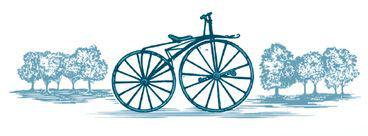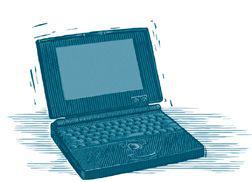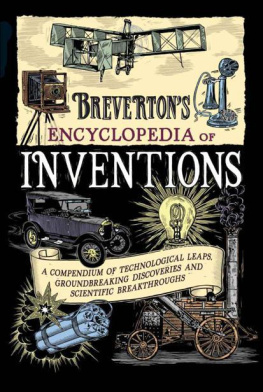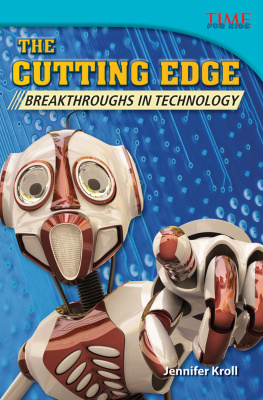BREVERTONS ENCYCLOPEDIA OF INVENTIONS


BREVERTONS ENCYCLOPEDIA OF INVENTIONS
A COMPENDIUM OF TECHNOLOGICAL LEAPS, GROUNDBREAKING DISCOVERIES AND SCIENTIFIC BREAKTHROUGHS
TERRY BREVERTON

Quercus Publishing Plc
55 Baker Street
7th Floor, South Block
London
W1U 8EW
First published in 2012
Copyright Quercus Editions Ltd 2012
All rights reserved. No part of this publication may be reproduced, stored in a retrieval system, or transmitted in any form or by any means, electronic, mechanical, photocopying, recording, or otherwise, without the prior permission in writing of the copyright owner and publisher.
The picture credits constitute an extension to this copyright notice.
Every effort has been made to contact copyright holders. However, the publishers will be glad to rectify in future editions any inadvertent omissions brought to their attention.
Quercus Publishing Plc hereby exclude all liability to the extent permitted by law for any errors or omissions in this book and for any loss, damage or expense (whether direct or indirect) suffered by a third party relying on any information contained in this book.
A catalogue record of this book is available from the British Library
eBook ISBN: 978-1-78087-340-4
UK and associated territories:
Print ISBN: 978-1-78087-239-1
Canada:
Print ISBN: 978-1-84866-190-5
10 9 8 7 6 5 4 3 2 1
You can find this and many other great books at:
www.quercusbooks.co.uk
Text by Terry Breverton
Edited by Philip de Ste. Croix
Designed by Paul Turner and Sue Pressley, Stonecastle Graphics Ltd
Index by Philip de Ste. Croix
Picture credits
Dover Publications Inc.: 10, 11, 17, 19, 20, 21, 26, 28, 40, 41, 64, 68, 73, 75, 76, 79, 83 (above), 83 (below right), 85, 87, 89, 90, 91, 93, 94, 99, 102, 111, 113, 120, 121, 127, 130, 134, 139, 140, 143, 152, 154, 157, 159 (below right), 161 (above), 161 (below right), 168, 176, 178, 179, 181, 183, 184, 186 (below), 189 (above), 189 (below right), 191, 192, 196, 197, 203, 204, 208, 211, 212, 213, 215, 220, 224, 228, 229, 232, 237, 240, 244, 249, 250, 253, 254, 255, 257, 258, 259, 260, 262, 281, 289, 310, 338, 367, 371, 373, 374, 376, 377, 378, 379, 380, 381, 382
Shutterstock.com: 123 (Antonio Abrignani), 314 (pzAxe), 316 (TerryM), 320 (CreativeHQ), 328 (Sebastian Kaulitzki), 330 (Liewluck), 334 (aarrows), 342 (Marco Rullkoetter), 350 (Georg Preissl), 351 (andrea crisante), 352 (3777190317), 364 (Lasse Kristensen), 366 (Oleksiy Mark)
Creative Commons Attribution: 55 (Angelus), 343 (Lucien Monfils), 345 (Bilby), 347 (Garmin), 358 (Karlmumm), 362 (Be H Map KOBCK ), 369 (Lane Hartwell)
Quercus Publishing Plc / Bill Donohoe: 1, 2, 3, 4, 5, 6
All other images are in the public domain.
Brought to you by KeVkRaY
CONTENTS




INTRODUCTION

This book tells us about the extraordinary discoveries and inventions that have contributed to knowledge and progress through breakthroughs in science and technology. The efforts and ingenuity of mankind from the earliest, most basic of discoveries to todays most cutting-edge have shaped the modern world, and continue to allow the human race to evolve to reach its fullest potential.
All collections such as this are bound in some way to be subjective. For instance, does the discovery of a treatment for a rare form of cancer compare with the development of the ability to perform transplant operations? Also, for some inventions and discoveries we have specific times, places and individuals who are responsible, but where do we place, or even include, the discovery of how to make fire? Again, one would think that the invention of buttons enabled us to develop todays clothing, but in fact it was the unknown 13th-century inventor of the buttonhole which allowed this.
UNKNOWN HEROES OF SCIENCE
Even when we come to known inventors or discoverers, sometimes they are standing on the shoulders of giants , following on from a long line of original thinkers. In other cases, the wrong inventor has been attributed because he or she was better at innovating or marketing, or simply better-known. Thus, you will surprisingly read about Merlyn Pryce and the discovery of Penicillium notatum mould in 1928, and of the men and women who developed penicillin, the antibiotic agent which has saved millions of lives and not Alexander Fleming. And the genius Nikola Tesla, carrying on the work of David Hughes, was really responsible for the radio, not the commonly attributed Marconi. Equally, Joseph Swan, not Thomas Edison, developed the electric light bulb. There are more than 20 great ideas which changed todays world, which have been re-attributed in this text. Thus this is not a regurgitation or a re-hash of past books upon inventions and discoveries, but a genuine attempt to discover who has improved or changed our lives, and in what ways. I have attempted to include whoever has contributed in some major way to learning, medicine and the sciences in general. However, great artists are not included. Although we can quite easily say that Shakespeare or T.S. Eliot or Rembrandt have helped us advance culturally, we cannot say that they have changed the world in any concrete manner. Also, this book does not include only those who have altered the world for the better, but also those responsible for weapons of destruction. Sometimes an innovator rather than an inventor or discoverer has been included, where their contribution has been of major significance. Some entries are longer than others, such as those on the unknown, yet prolific, geniuses David Hughes and Richard Trevithick. This usually has been carried out in the interest of putting the record straight.
FROM PREHISTORY TO THE SCIENTIFIC AND INDUSTRIAL REVOLUTIONS
The book begins with prehistory the knife, fish hook, cloth and sewing needle, quern-stone and bow and arrow. Then we move to the ancients the Sumerians, Chaldeans, Egyptians, Greeks and Romans with mathematics, astronomy, theory of atoms, lever and astrolabe. It is astonishing how much was known, say, about the existence of atoms and their indestructibility at this time. Men knew that the Earth was round, and that it was not the centre of the Universe, but an incredible amount of knowledge was lost during the ensuing Dark Ages of Western civilization. However, during these centuries, the Chinese and Islamic worlds made great advances with clocks, gunpowder, medicine, surgery, gears, algebra, crankshafts and the compass. Then with the Renaissance in the Western world, we began to rediscover what had been lost. Gutenbergs printing press of 133640 began to disseminate scientific thought from the Arab world to the West, and the great Scientific Revolution took place in line with the Renaissance, with the conformist teachings of the church being slowly overthrown in many aspects of life. This was the age of da Vinci, Copernicus, Galileo, Harvey, Boyle, Hooke and Newton men who changed the world. In turn, this era of scientific curiosity, experimentation and discovery led to the Industrial Revolution, responsible for the modern age. We see the appearance of steam engines, textile machinery, the development of the factory system, electricity, pulped paper and the mechanized steel industry.
Next page














